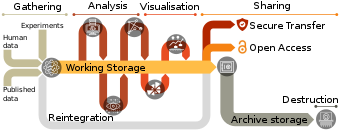Data management
Data management comprises all disciplines related to managing data as a valuable resource.
Concept
The concept of data management arose in the 1980s as technology moved from sequential processing [1] (first punched cards, then magnetic tape) to random access storage. Since it was now possible to store a discrete fact and quickly access it using random access disk technology, those suggesting that data management was more important than business process management used arguments such as "a customer's home address is stored in 75 (or some other large number) places in our computer systems." However, during this period, random access processing was not competitively fast, so those suggesting "process management" was more important than "data management" used batch processing time as their primary argument. As application software evolved into real-time, interactive usage, it became obvious that both management processes were important. If the data was not well defined, the data would be mis-used in applications. If the process wasn't well defined, it was impossible to meet user needs.
Topics
Topics in data management include:
- Data governance
- Data architecture
- Data modeling and design
- Database and storage management
- Data security
- Reference and master data
- Data Integration and inter-operability
- Documents and content
- Data warehousing and business intelligence and Analytics
- Metadata
- Data quality
Usage
| Part of a series on |
| Library and information science |
|---|
 |
In modern management usage, the term data is increasingly replaced by information or even knowledge in a non-technical context. Thus data management has become information management or knowledge management. This trend obscures the raw data processing and renders interpretation implicit. The distinction between data and derived value is illustrated by the information ladder. However, data has staged a comeback with the popularisation of the term big data, which refers to the collection and analyses of massive sets of data.
Several organisations have established data management centers (DMC) for their operations.[2]
``
See also
- Open data
- FAIR data
- Pseudonymization
- Information architecture
- Enterprise architecture
- Information design
- Information system
- Controlled vocabulary
- Data curation
- Data retention
- Data Management Association
- Data management plan
- Data mesh, a domain-oriented data architecture[3]
- Computer data storage
- Data proliferation
- Digital preservation
- Document management
- Enterprise content management
- Hierarchical storage management
- Information repository
- Machine-readable documents
- Performance report
- System integration
- Customer data integration
- Identity management
- Identity theft
- Data theft
- ERP software
- CRM software
References
- ^ Hoare, C. A. R. (2004) [1985]. Communicating Sequential Processes. Prentice Hall International. ISBN 978-0-13-153271-7.
- ^
For example: Kumar, Sangeeth; Ramesh, Maneesha Vinodini (2010). "Lightweight Management framework (LMF) for a Heterogeneous Wireless Network for Landslide Detection". In Meghanathan, Natarajan; Boumerdassi, Selma; Chaki, Nabendu; Nagamalai, Dhinaharan (eds.). Recent Trends in Networks and Communications: International Conferences, NeCoM 2010, WiMoN 2010, WeST 2010,Chennai, India, July 23-25, 2010. Proceedings. Communications in Computer and Information Science. Vol. 90. Springer. p. 466. ISBN 9783642144936. Retrieved 2016-06-16.
4.4 Data Management Center (DMC)[:] The Data Management Center is the data center for all of the deployed cluster networks. Through the DMC, the LMF allows the user to list the services in any cluster member belonging to any cluster [...].
- ^ "Data Mesh: Delivering data-driven value at scale".
External links
 Media related to Data management at Wikimedia Commons
Media related to Data management at Wikimedia Commons- Data management at Curlie


